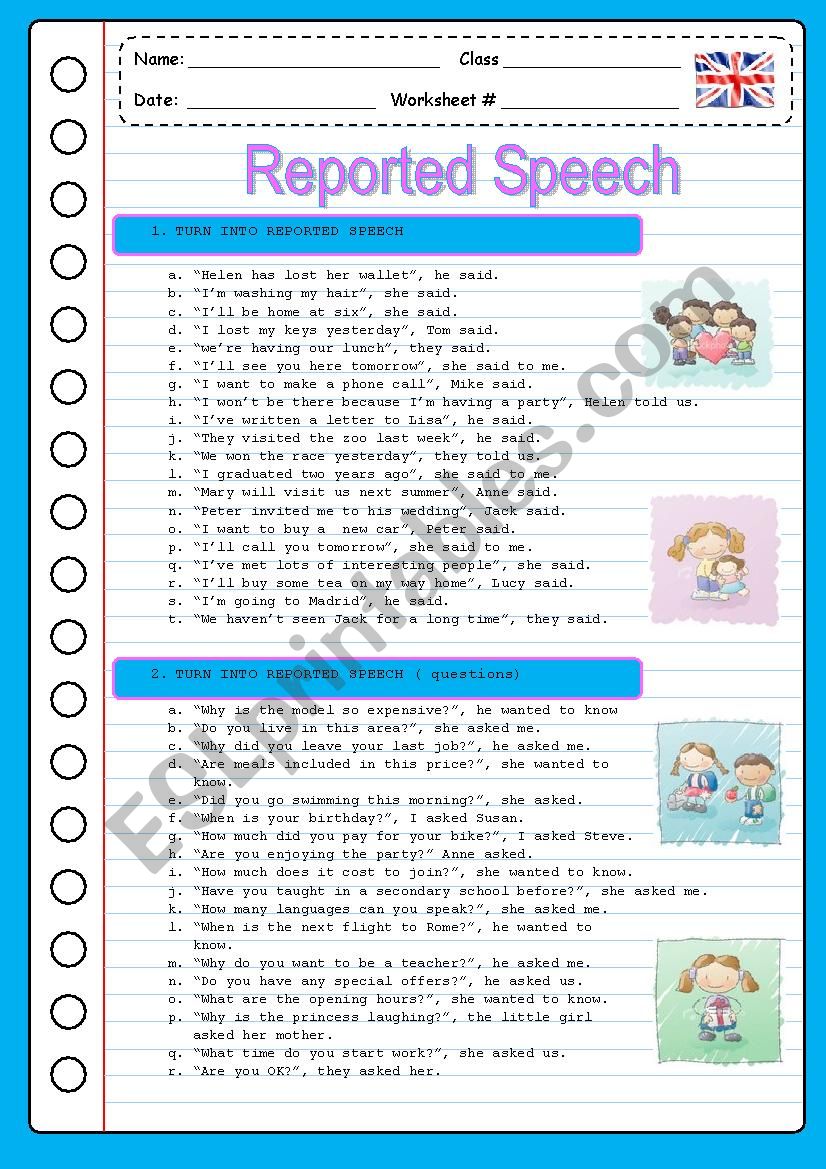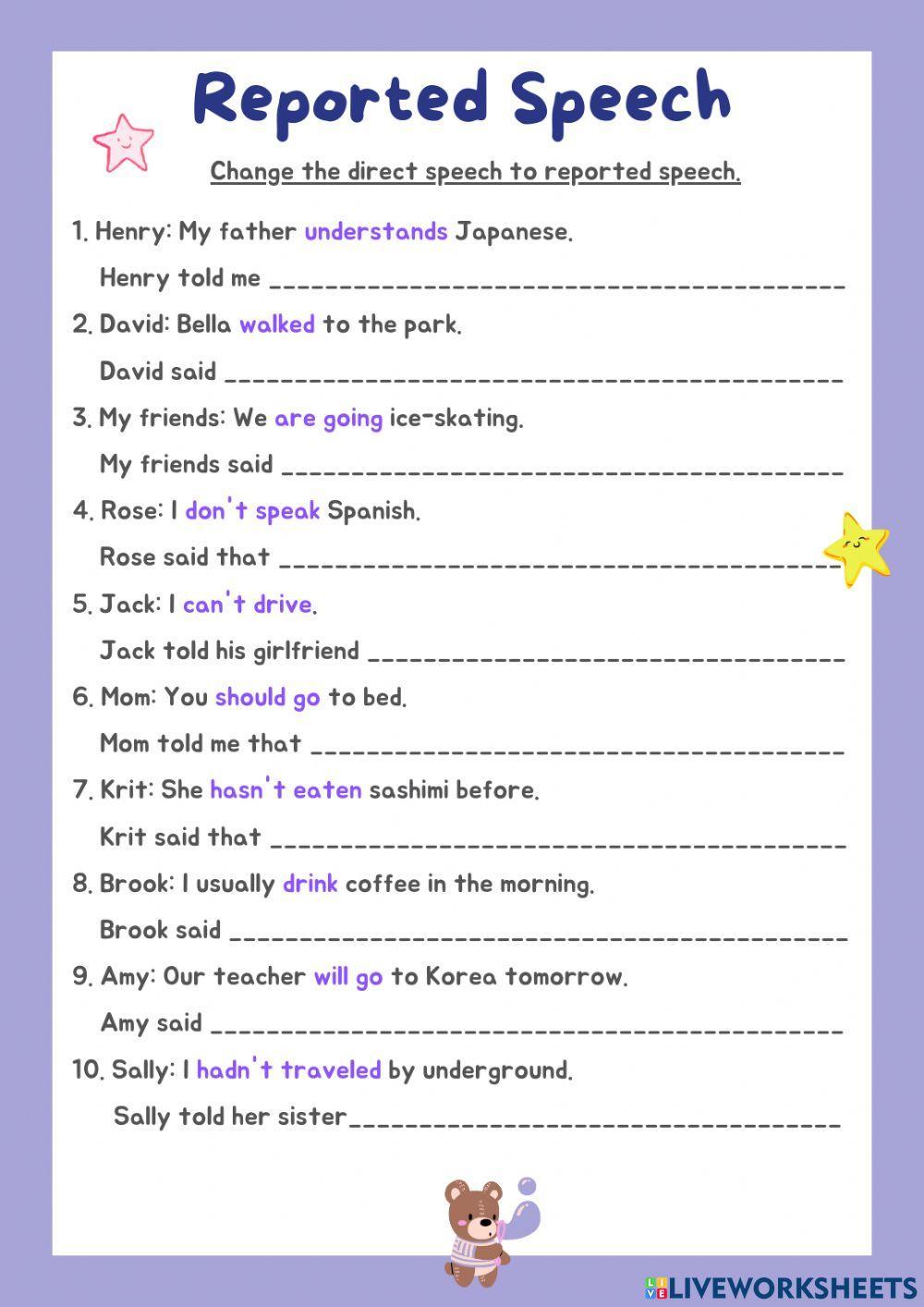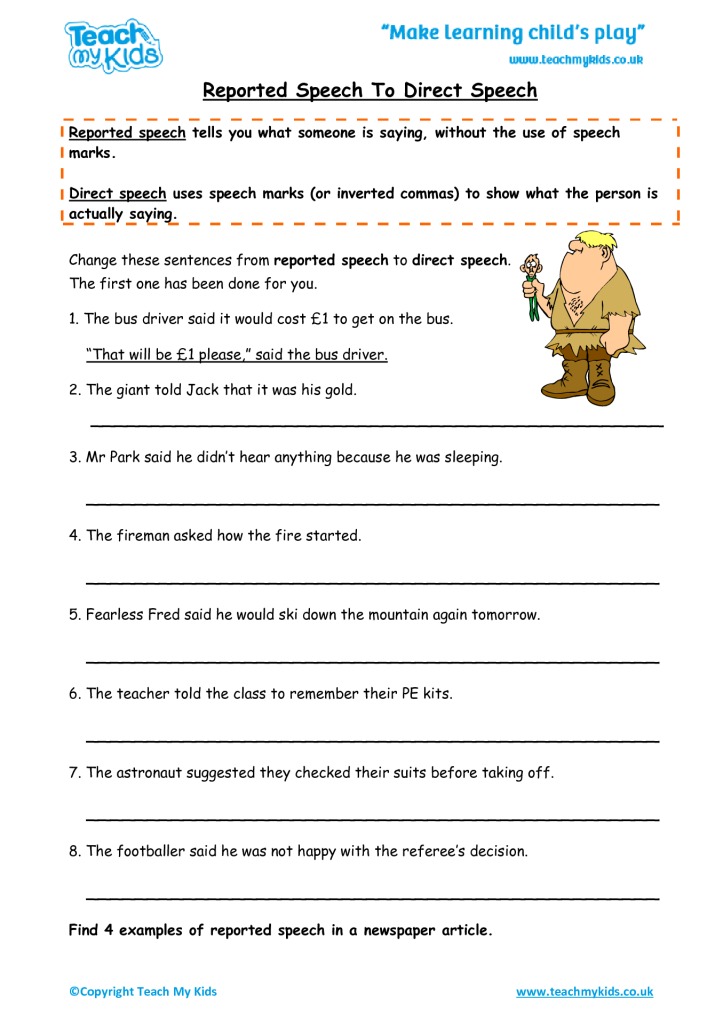
Mastering the Art of Reporting: The Essential Role of Reported Speech Worksheets
Communication is the cornerstone of human interaction, and a significant part of effective communication involves relaying information, stories, and conversations. This act of recounting what someone else has said is formally known as reported speech, also often referred to as indirect speech. While seemingly straightforward, mastering reported speech presents a unique set of grammatical challenges, from tense shifts and pronoun changes to alterations in time and place expressions. For English language learners, navigating these complexities can be a daunting task. This is precisely where reported speech worksheets emerge as an invaluable, indispensable tool.
This comprehensive article will delve into the intricacies of reported speech, explore why it’s a critical skill, and, most importantly, highlight how well-designed reported speech worksheets can serve as the bedrock of successful learning and teaching strategies. We will examine the different types of worksheets, their key components, how to effectively integrate them into a learning plan, and where to find high-quality resources, ultimately aiming to equip learners and educators with the knowledge to conquer this essential grammatical concept.
Understanding the Nuances of Reported Speech

Before diving into the utility of worksheets, it’s crucial to grasp what reported speech entails and why it often trips up learners. In essence, reported speech is the way we convey the content of someone else’s statement, question, or command without quoting them directly.

Consider these examples:

- Direct Speech: "I am going to the park tomorrow," she said.
- Reported Speech: She said that she was going to the park the next day.


The transformation involves several key changes:
- Tense Shift (Backshift): The verb tense in the reported clause usually "moves back" one step in time.

- Present Simple -> Past Simple
- Present Continuous -> Past Continuous
- Present Perfect -> Past Perfect
- Past Simple -> Past Perfect
- Will -> Would
- Can -> Could
- May -> Might
- Must -> Had to



- Pronoun Changes: Pronouns often need to be adjusted to reflect the new speaker. ("I" becomes "he/she," "my" becomes "his/her," etc.)
- Time and Place Expressions: Adverbs of time and place typically change.
- "Now" -> "then"
- "Today" -> "that day"
- "Yesterday" -> "the day before" / "the previous day"
- "Tomorrow" -> "the next day" / "the following day"
- "Here" -> "there"
- "This" -> "that" / "the"
- Reporting Verbs: The choice of reporting verb (e.g., said, told, asked, explained, advised, ordered) can influence the structure and meaning.
- Questions and Commands: These require specific structural changes, often involving "if/whether" for yes/no questions, or "to + infinitive" for commands.
The sheer number of rules and exceptions, combined with the need for simultaneous application, makes reported speech a challenging area. Without consistent, structured practice, learners can easily become overwhelmed and make persistent errors.
The Indispensable Role of Reported Speech Worksheets
This is where reported speech worksheets step in as an indispensable educational tool. They provide a structured, repetitive, and progressively challenging environment for learners to practice and internalize the complex rules. Unlike passive learning, worksheets demand active engagement, forcing learners to apply the rules rather than just memorize them.
Here’s why they are so crucial:
- Structured Practice: Worksheets break down the learning process into manageable steps, allowing learners to focus on one rule at a time before combining them.
- Reinforcement: Repetition is key to mastery. Worksheets offer ample opportunities to practice the same rules in different contexts, solidifying understanding.
- Identification of Weaknesses: By completing exercises, learners (and teachers) can quickly identify specific areas where errors consistently occur, allowing for targeted review.
- Self-Assessment: Many worksheets come with answer keys, enabling learners to check their own work, understand their mistakes, and learn independently.
- Variety of Exercise Types: Good worksheets offer diverse exercise formats, preventing monotony and catering to different learning styles.
- Application of Rules: Rather than just theoretical understanding, worksheets compel learners to actively apply the transformation rules.
Types of Effective Reported Speech Worksheets
Effective worksheets are not monolithic; they come in various forms, each designed to target specific aspects of reported speech. A comprehensive learning plan should incorporate a mix of these types:
- Basic Transformation Drills (Statements): These are the foundation. Learners are given direct statements and asked to convert them into reported speech. These often start with simple present tense sentences and gradually introduce more complex tenses.
- Example: "I live in London," he said. -> He said he lived in London.
- Question Transformation Worksheets: These focus specifically on converting direct questions into reported questions. They typically differentiate between yes/no questions (using "if" or "whether") and wh-questions (retaining the wh-word).
- Example (Yes/No): "Are you coming?" she asked. -> She asked if I was coming.
- Example (Wh-): "Where do you work?" he inquired. -> He inquired where I worked.
- Command and Request Worksheets: These focus on using reporting verbs like "told," "asked," "ordered," "advised," followed by an object and an infinitive.
- Example: "Close the door," he told me. -> He told me to close the door.
- Example: "Please help me," she begged. -> She begged me to help her.
- Mixed Exercise Worksheets: Once learners have a grasp of individual types, mixed exercises are crucial. These combine statements, questions, and commands, forcing learners to identify the type of sentence and apply the correct transformation rules. This mirrors real-life communication.
- Dialogue Transformation Worksheets: These present a short dialogue in direct speech, and learners must convert the entire conversation into reported speech. This helps learners see reported speech in a more natural, extended context.
- Error Correction Worksheets: Learners are given sentences already in reported speech, but with subtle errors (e.g., incorrect tense shift, wrong pronoun, missing conjunction). They must identify and correct these mistakes, fostering a deeper understanding of the rules.
- Gap-Filling and Multiple-Choice Worksheets: These are excellent for quick assessments or reinforcing specific rules. Learners choose the correct reported form from a selection or fill in missing words.
- Contextualized Scenario Worksheets: More advanced worksheets might present a scenario (e.g., a news report, a summary of a meeting) and ask learners to report what different people said within that context. This develops real-world application skills.
Crafting and Utilizing Effective Reported Speech Worksheets
Whether you are an educator creating your own materials or a learner seeking out resources, certain characteristics define high-quality reported speech worksheets:
- Clear Instructions: Ambiguity hinders learning. Instructions should be concise and easy to understand.
- Gradual Difficulty: Start simple and progressively introduce more complex structures. This builds confidence and mastery.
- Ample Practice Space: Ensure there’s enough room for learners to write their answers clearly.
- Varied Examples: Use a range of subjects, verbs, and contexts to keep the exercises engaging and illustrate the broad applicability of reported speech.
- Inclusion of Answer Keys: Crucial for self-correction and independent learning. For teachers, it streamlines grading.
- Relevance: Whenever possible, use sentences and scenarios that are relatable or interesting to the learner.
- Visual Appeal: A well-organized, clean layout is easier on the eyes and less intimidating.
Integrating Worksheets into Your Learning Strategy
Worksheets are most effective when integrated thoughtfully into a broader learning plan:
- Pre-Lesson Introduction: Use a simple worksheet to gauge learners’ existing knowledge before introducing new concepts.
- In-Class Practice: After explaining a rule, use a targeted worksheet for immediate application and clarification. Teachers can circulate to provide instant feedback.
- Homework Assignments: Worksheets make excellent homework, allowing learners to consolidate what they’ve learned in a low-pressure environment.
- Review and Reinforcement: Periodically revisit reported speech with mixed worksheets to ensure long-term retention.
- Pair and Group Work: Encourage learners to complete worksheets collaboratively. Discussing answers fosters deeper understanding and promotes peer learning.
- Self-Study: For independent learners, worksheets with clear explanations and answer keys are invaluable for self-paced mastery.
Where to Find High-Quality Reported Speech Worksheets
The digital age has made finding educational resources easier than ever. Here are some prime sources for excellent reported speech worksheets:
- ESL/EFL Websites: Many reputable websites dedicated to English language learning (e.g., British Council LearnEnglish, ESL-Lab, ThoughtCo, Breaking News English) offer free, printable worksheets. These are often categorized by level and topic.
- Teacher Resource Platforms: Websites like Teachers Pay Teachers (for a fee, but often high quality), or blogs by experienced ESL teachers often share their self-created materials.
- Textbooks and Workbooks: Traditional textbooks usually include comprehensive sections and exercises on reported speech. These are often vetted and logically structured.
- Educational Publishers: Major educational publishers (e.g., Cambridge University Press, Oxford University Press, Pearson) offer accompanying workbooks or online resources for their grammar series.
- AI Tools (e.g., ChatGPT): With careful prompting, AI tools can generate custom reported speech exercises. You can specify the level, types of sentences, and even provide a theme. However, always review AI-generated content for accuracy and appropriateness.
- Creating Your Own: For specific needs, creating your own worksheets allows for ultimate customization. You can tailor them to your learners’ interests, current events, or specific error patterns.
Beyond the Worksheet: Complementary Activities
While reported speech worksheets are foundational, they should be complemented by other activities to ensure holistic mastery and the ability to use reported speech fluently in real-world contexts:
- Role-Playing: Have students interview each other and then report what their partner said to a third person.
- Games: Create board games or card games where players must transform sentences into reported speech.
- Listening Exercises: Play audio clips or videos, then ask learners to report what was said by different characters.
- Speaking Practice: Encourage learners to naturally incorporate reported speech into their conversations. For example, "My friend told me that she’s starting a new job next month."
- Writing Tasks: Assign tasks like summarizing a news article, reporting on a class discussion, or writing a diary entry recounting a conversation.
The Long-Term Benefits of Mastering Reported Speech
Proficiency in reported speech extends far beyond simply passing a grammar test. It significantly enhances a learner’s overall communicative competence:
- Clearer Communication: Accurately reporting what others have said avoids misunderstandings and adds precision to narratives.
- Academic Success: Essential for summarizing research, quoting sources, and reporting findings in academic papers.
- Professionalism: In business settings, accurately relaying information from meetings, calls, or colleagues is critical.
- Enhanced Fluency: Seamlessly integrating reported speech into conversations makes a speaker sound more natural and sophisticated.
- Storytelling: It allows for richer, more dynamic storytelling, whether in casual conversation or formal presentations.
Conclusion
Reported speech is undeniably one of the more challenging grammatical structures in English, demanding a keen eye for detail and consistent application of multiple rules. However, with the right approach and the right tools, it is a conquerable skill. Reported speech worksheets stand out as a cornerstone of this conquest, providing the structured, repetitive, and varied practice necessary for learners to internalize the transformations and confidently apply them.
By understanding the types of worksheets available, recognizing the components of effective design, and strategically integrating them into a comprehensive learning journey alongside complementary activities, educators can empower their students, and learners can empower themselves, to master reported speech. This mastery not only unlocks a crucial grammatical skill but also significantly elevates overall English proficiency, paving the way for more nuanced, precise, and effective communication in all facets of life. Embrace the power of reported speech worksheets – they are your gateway to reporting success.
